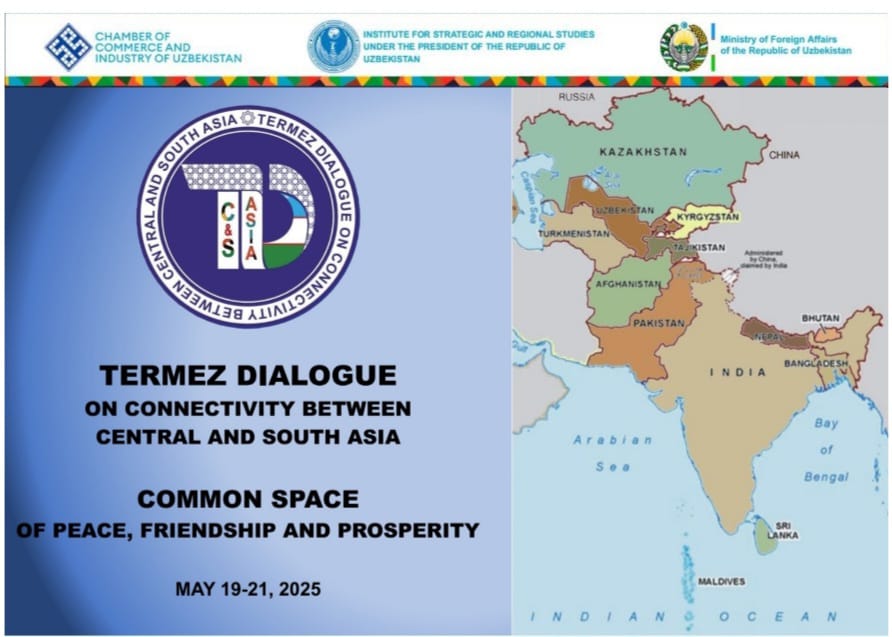As is known, the first meeting of the Termez Dialogue on Connectivity between Central and South Asia, dedicated to the theme “Building a Common Space for Peace, Friendship, and Prosperity,” will be held in Termez on May 19-21, 2025.
This meeting is expected to be attended by representatives of the foreign policy agencies of Central and South Asian countries, which are becoming the focus of world politics, as well as representatives of specialized UN organizations, international and regional organizations such as the CIS, the SCO, the CICA, and leading specialists and experts in relevant fields.
Central and South Asia have long been connected by reliable trade routes and have served as a bridge between the countries of the Middle East, Europe, and China. The peoples of this region share historical and civilizational commonalities, having repeatedly existed within common state associations in the past, as well as within a single political, economic, and humanitarian space. Over many centuries, relations between the two regions have been strengthened by numerous migration flows, intensive trade exchanges, rapid dissemination of scientific ideas, and cultural cross-pollination.
As a result of the spread of Zoroastrianism, Hinduism, Buddhism, and Islam in these regions, unique ethnocultural associations formed, which left a deep mark on human history.
The incorporation of the peoples of this region into such states as the Bactrian and Kushan kingdoms, the Turkic Khaganate, Khorasan and Transoxiana, the Ghaznavid, Timurid, and Mughal empires had a great influence on their historical, cultural, and political development. Common customs, traditions, lifestyles, and holidays were formed; common spiritual values were created in different languages of two regions.
The mutual competition of colonial powers negatively affected the traditional ties, trade, and cultural exchange of the peoples of Central and South Asia. Trade and economic relations in South Asia changed, and local supply systems, main industries, and economies became dependent on supplies from outside the region. This development weakened the traditional cultural ties between South Asia and Central Asia.
Today, jointly addressing existing problems that threaten peace and stability in the region is one of the important factors in the social, cultural, and economic development of these countries. Therefore, the renewal of their close historical ties is becoming increasingly relevant. Taking the above into account, the Termez Dialogue on the Connectivity between Central and South Asia is being organized.
The location chosen for the dialogue is connected to the geostrategic position of this city, situated at the crossroads of Central and South Asia, or at the intersection of interregional connectivity routes. Termez has long been a center of trade, economy, and crafts, serving as a link between the vast regions of Central and South Asia. Therefore, from a geopolitical perspective, the city can be considered a “natural bridge” connecting Central and South Asia, the most suitable place for bringing the peoples of the region closer together through its historical location and cultural heritage.
Currently, the countries of Central and South Asia represent a territory of global significance, with a population of more than 2 billion people and great educational potential. The region is experiencing high demographic growth, with the majority of the population consisting of young people, and there are enormous opportunities for realizing intellectual potential. While the population of South Asian countries is about 2 billion people, the number of people living in Central Asia is about 82 million, and the population of Central Asian states is growing year by year. The countries exhibit a “disparity in literacy levels.” For example, among the leading countries of Central Asia, the average adult literacy rate is 99 percent, while in South Asia it is 74 percent.
One of the pressing problems is the uneven quality of education, insufficient coverage of preschool and higher education, especially among girls and residents of remote areas. In South Asia, youth unemployment remains high, and in some countries, this figure exceeds 40 percent. At the same time, the employment rate of women is one of the lowest in the world. In addition, the infrastructure of educational systems is not sufficiently developed, and the shortage of specialists and teacher qualifications also creates a number of problems.
In this context, cooperation in the field of science and education is becoming increasingly relevant. Scientific cooperation in the context of digitalization and geopolitical instability will allow for maintaining dialogue between academic circles. At the same time, limited academic mobility and weak coordination between scientific communities significantly hinder the development of states’ potential in science, innovation, and technology.
In this regard, it is necessary to encourage joint research and innovation work, the organization of scientific and educational internships, experience exchange programs, the development of startups, and the holding of competitions.
The adoption of a joint program of academic and research exchanges under the auspices of UNESCO is becoming relevant. It is also necessary to launch an online platform between universities and research structures of the countries of Central and South Asia.
This will contribute to the creation of a sustainable regional network of scientific diplomacy, the formation of a common agenda in the field of education and technology, and the emergence of a unified scientific space.
The above-mentioned steps will serve as a powerful tool for the development of scientific diplomacy, which will facilitate interaction between the countries of the two regions.
From this point of view, the integration of intellectual resources in Central and South Asia, strengthening cooperation in the field of education, and developing cooperation platforms to improve the quality of education are important for the future of the region. The transformation of demographic potential into human capital is the main condition for sustainable development, economic growth, and a worthy place in global competition for both regions. In this regard, the development of education as one of the priority areas of regional cooperation, the development of partnerships for the exchange of experience and training of personnel in various countries is most relevant.
The countries of South Asia have in recent decades been occupying an increasingly prominent place in the world community in the field of science, technology, and innovation.
Pakistan is making progress in science, especially in nuclear energy and military technologies. Centers such as COMSATS University and the Pakistan Institute of Engineering and Applied Sciences (PIEAS) play a crucial role in the country’s scientific development. In particular, government programs are being implemented to strengthen international cooperation in IT and cybersecurity.
Information technology, aeronautics, pharmaceutical production, and artificial intelligence are rapidly developing in India. In the field of information technology, country has become one of the world’s largest IT outsourcing centers.
In Bangladesh, alongside the textile and light industry, information technology is developing rapidly. Based on the “Digital Bangladesh” strategy, the country has widely implemented e-government, digital, and distance learning services. In 2021, over 120 IT parks were established in Bangladesh, demonstrating the country’s commitment to digitalizing its economy.
Afghanistan’s scientific and technological potential remains limited, and issues related to political stability are hindering its development. Nevertheless, some universities and educational institutions in the country, particularly Kabul University, participate in scientific projects with the support of various international educational organizations.
In this context, developing a joint strategy for digital connectivity between Central and South Asia is crucial. Adopting such a document will create significant opportunities for stimulating trade and investment, improving access to education and healthcare, strengthening regional cooperation, and increasing competitiveness on the global stage.
Coordinating efforts of Central and South Asian countries to widely implement the digital economy will contribute to improving digitalization processes in all spheres of life. Moreover, this will advance the implementation of the SDG initiative to ensure safe Internet access for the population and will open up great opportunities for education and medical services.
Overall, deepening digital connectivity between Central and South Asia will bring significant economic and social benefits to both regions, create a solid foundation for expanding trade, economic, energy, and transport links, and enhance the competitiveness of the region’s states on the global arena.
In general, the Termez Dialogue is an important initiative that contributes to elevating the interaction between Central and South Asian states to a new level in the process of today’s geopolitical and civilizational transformations. This dialogue, particularly in the fields of education, science, and new technologies, will stimulate, consolidate, and expand the intellectual potential of the two regions. This is because in both regions, the majority of the population consists of young people who show high interest in education, are capable of scientific research, and quickly adapt to digital technologies.
Today, countries such as India, Pakistan, and Bangladesh have achieved world-class successes in information technology, biotechnology, nuclear physics, medicine, and artificial intelligence, while Uzbekistan, Kazakhstan, and other Central Asian countries are also taking active measures to update scientific infrastructure, expand international cooperation, and implement modern educational projects. The Termez Dialogue is a unique opportunity to combine this experience and achievements, establish student and scholar exchanges, create joint research centers, and develop startups and innovative platforms in IT and STEM.
This dialogue has great historical significance in ensuring regional stability, creating a foundation for peace, progress, and intellectual development through science and education. The states of Central and South Asia have the potential to become the leading intellectual center in the entire Eurasian space based on the principle of mutual trust and shared future, integration in the spheres of education and science.


